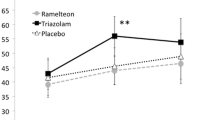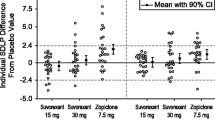Abstract
Introduction
First-generation antihistamines taken for relief of allergic rhinitis are sedating and pose potential risks for those driving a car or operating machinery. Desloratadine is a potent, selective, histamine H1-receptor antagonist that does not easily cross the blood–brain barrier. It is nonsedating at therapeutic doses and should not affect driving or psychomotor performance.
Objective
This study compared the acute effects of desloratadine with diphenhydramine (active control) and placebo on the performance of healthy subjects evaluated with standard over-the-road driving tests (primary objective). The subjects’ performances were also evaluated (secondary objective) with the use of conventional performance tests.
Methods
Eighteen men and women received a single dose of desloratadine 5 mg, diphenhydramine 50 mg, or placebo during each period of this randomized, double-blind, three-way, crossover study. Two hours post-dosing, subjects operated a specially instrumented vehicle in a 90-min test designed to measure their ability (1) to maintain constant speed and lateral position while following another vehicle at a constant distance and (2) to respond to brake signals. Additionally, a full battery of performance tests was administered.
Results
No significant differences were noted between desloratadine and placebo in standard deviation of lateral position (SDLP), whereas diphenhydramine treatment significantly increased SDLP (P<0.001 for both comparisons). Brake reaction time was significantly faster following treatment with desloratadine than diphenhydramine (473.72 ms vs 541.22 ms; P<0.001) or placebo (512.06 ms; P=0.033). No differences were seen among treatments in deviation of speed or distance to the lead car. The majority of performance tests showed no significant differences among groups.
Conclusion
Desloratadine at a therapeutic dose does not impair driving performance.




Similar content being viewed by others
References
O’Hanlon JF (1988) Antihistamines and driving safety. Cutis 42:10–13
Ramaekers JG, Uiterwijk MMC, O’Hanlon JF (1992) Effects of loratadine and cetirizine on actual driving and psychometric test performance and EEG during driving. Eur J Clin Pharmacol 42:363–369
Volkerts ER, Van Laar M (1995) Specific review of the psychometric effects of cetirizine. Allergy 50:55–60
O’Hanlon JF, Ramaekers JG (1995) Antihistamine effects on actual driving performance in a standard test: a summary of Dutch experience, 1989–94. Allergy 50:234–242
Wilken JA, Berkowitz R, Kane R (2002) Decrements in vigilance and cognitive functioning associated with ragweed-induced allergic rhinitis. Ann Allergy Asthma Immunol 89:372–380
Spaeth J, Klimek L, Mosges R (1996) Sedation in allergic rhinitis is caused by the condition and not by antihistamine treatment. Allergy 51:893–906
Marshall PS, O’Hara C, Steinberg P (2000) Effects of seasonal allergic rhinitis on selected cognitive abilities. Ann Allergy Asthma Immunol 84:403–410
Simons FE, Simons KJ (1999) Clinical pharmacology of new histamine H1 receptor antagonists. Clin Pharmacokinet 36:329–352
Simons FER (1999) H1-receptor antagonists: safety issues. Ann Allergy Asthma Immunol 83:481–488
Kay GG, Quig ME (2001) Impact of sedating antihistamines on safety and productivity. Allergy Asthma Proc 22:281–283
Salmun L, Lorber R (2002) 24-hour efficacy of once-daily desloratadine therapy in patients with seasonal allergic rhinitis [ISRCTN32042139]. BMC Fam Pract 3:14
Meltzer E, Prenner B, Nayak A, Desloratadine Study Group (2001) Efficacy and tolerability of once-daily 5 mg desloratadine, an H1-receptor antagonist, in patients with seasonal allergic rhinitis: assessment during the spring and fall allergy seasons. Clin Drug Invest 21:25–32
Scadding GK (2002) Desloratadine in the treatment of nasal congestion in seasonal allergic rhinitis. Preclinical and clinical evidence. Clin Drug Invest 22[Suppl 2]:21–32
Nayak AS, Schenkel E (2001) Desloratadine reduces nasal congestion in patients with intermittent allergic rhinitis. Allergy 56:1077–1080
Simons FER, Prenner BM, Finn A (2003) Efficacy and safety of desloratadine in the treatment of perennial allergic rhinitis. J Allergy Clin Immunol 111:617–622
Bachert C, Virchow JC, Plenker A (2002) Desloratadine in the treatment of seasonal allergic rhinitis: results of a large observational study. Clin Drug Invest 22[Suppl 2]:43–52
Gupta S, Banfield C, Affrime M, Marco A, Cayen M, Herron J, Padhi D (2002) Desloratadine demonstrates dose proportionality in healthy adults after single doses. Clin Pharmacokinet 41[Suppl]:1–6
Nayak A, Salmun LM, Lorber RR (2000) Desloratadine relieves nasal congestion in patients with seasonal allergic rhinitis. Allergy 55[Suppl 63]:193–194
Kreutner W, Hey JA, Chiu P, Barnett A (2000) Preclinical pharmacology of desloratadine, a selective and nonsedating histamine H1-receptor antagonist. Second communication: lack of central nervous system and cardiovascular effects. Arzneimittelforschung 50:441–448
Rikken G, Scharf MB, Danzig MR, Staudinger H (2000) Desloratadine and alcohol co-administration: no increase in impairment of performance over that induced by alcohol alone. Allergy 55[Suppl 63]:277
O’Hanlon JF, Haak TW, Blaauw GJ, Riemersma JB (1982) Diazepam impairs lateral position control in highway driving. Science 217:79–81
Vuurman EF, Muntjewerff ND, Uiterwijk MM, Van Veggel LM, Crevoisier C, Haglund L, Kinzig M, O’Hanlon JF (1996) Effects of mefloquine alone and with alcohol on psychomotor and driving performance. Eur J Clin Pharmacol 50:475–482
Ramaekers G, Lamers J, Verhey F, Muntjewerff D, Mobbs E, Sanders N, Lewis M, Lockton A (2002) A comparative study of the effects of carbamazepine and the NMDA receptor antagonist remacemide on road tracking and car-following performance in actual traffic. Psychopharmacology 159:203–210
Hoddes E, Zarcone V, Smythe H, Phillips R, Dement WC (1973) Quantification of sleepiness: a new approach. Psychophysiology 10:431–436
Kapetyn TS, Bles W, Njiokiktjein CHJ, Kodde I, Massen CH, Mol JMF (1983) Standardization in platform stabilimetry being part of posturography. Agressology 24:321–326
Rey A (1964) L’examine physiologique dans le cas d’encephalopathie traumatique. Presse Universitaires de France, Paris
Wechsler D (1981) The measurement and appraisal of adult intelligence. Williams and Wilkins, Baltimore
Vuurman EF, Uiterwijk MM, Rosenzweig P, O’Hanlon JF (1994) Effects of mizolastine and clemastine on actual driving and psychomotor performance in healthy volunteers. Eur J Clin Pharmacol 47:253–259
Jex HR, McDonnell JD, Phatak AV (1966) A “critical” tracking task for manual control research. IEEE Trans Human Factors Electron 7:138–145
Moskowitz H, Burns M (1977) The effects of alcohol and valium, singly and in combination, upon driving-related skills performance. In: Hulke D (ed) Proceedings of the 21st conference of the American Association for Automotive Medicine. American Association of Automotive Medicine, Morton Grove, Illinois, pp 226–240
Baddely AD (1968) A three-minute test based on grammatical transformation. Psychometric Science 72:257–269
Collins AM, Quillian MR (1969) Retrieval time from semantic memory. J Verbal Learn Verbal Behav 8:240–247
Brookhuis KA, De Vries G, De Waard D (1993) Acute and subchronic effects of the H1-histamine receptor antagonist ebastine in 10-, 20-, and 30-mg dose, and triprolidine 10 mg on car driving performance. Br J Pharmacol 36:67–70
Vermeeren A, O’Hanlon JF (1998) Fexofenadine’s effects, alone and with alcohol, on actual driving and psychomotor performance. J Allergy Clin Immunol 101:306–311
Weiler JM, Bloomfield JR, Woodworth GG, Grant AR, Layton TA, Brown TL, McKenzie DR, Baker TW, Watson GS (2000) Effects of fexofenadine, diphenhydramine, and alcohol on driving performance. A randomized, placebo-controlled trial in the Iowa driving simulator. Ann Intern Med 132:354–363
Volkerts ER, Van Willigenburg APP, Van Laar MW, Maes RAA (1992) Does cetirizine belong to the new generation of antihistamines? An investigation into its acute and subchronic effects on highway driving, psychometric test performance, and daytime sleepiness. Hum Psychopharmacol 7:227–238
Vermeeren A (2003) Hypnotics and antihistamines: effects on cognitive functions and driving performance (ISBN 90-75579-15-2). Thesis Neuropsych Publishers, Maastrict
Acknowledgement
This study was supported by a research grant from Schering-Plough Research Institute, Kenilworth, New Jersey.
Author information
Authors and Affiliations
Corresponding author
Rights and permissions
About this article
Cite this article
Vuurman, E.F.P.M., Rikken, G.H., Muntjewerff, N.D. et al. Effects of desloratadine, diphenhydramine, and placebo on driving performance and psychomotor performance measurements. Eur J Clin Pharmacol 60, 307–313 (2004). https://doi.org/10.1007/s00228-004-0757-9
Received:
Accepted:
Published:
Issue Date:
DOI: https://doi.org/10.1007/s00228-004-0757-9




